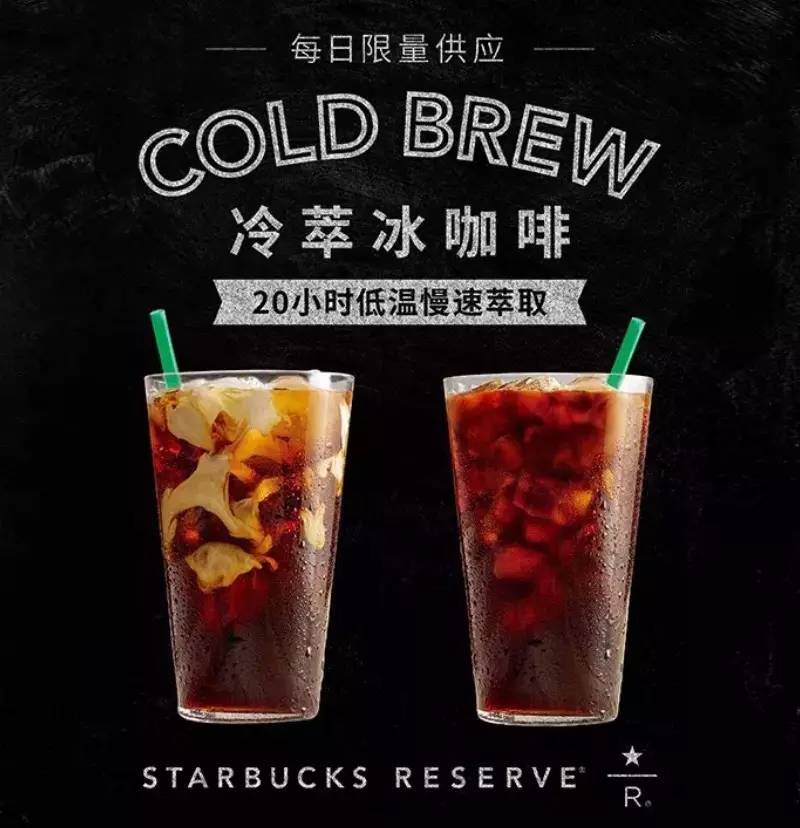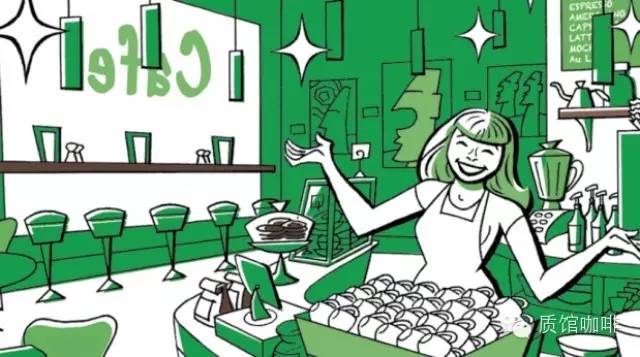How does Starbucks hook up with consumer coffee brands besides selling coffee?
Starbucks is no longer the only brand on the list of people choosing cafes for dates or business meetings. Nowadays, it takes more effort to "hook up" to sell coffee. How does the world's largest coffee chain retain unfaithful consumers?
Starbucks' response is to add. In addition to selling coffee, Starbucks has been sparing no effort to explore all the services that can be connected to the scene of drinking coffee, extending its business from the product level, offering music, newspaper reading, membership and other services.
Today we don't talk about its coffee, let's take a look at these various "tricks" that are more or less related to coffee.
Shop assistants have to wear aprons and do DJ.
Nothing goes better with coffee than music. Coffee shops are usually equipped with soft music to increase sentiment, but it is passively accepted by consumers, coffee shops also have no way to know consumers' preferences for listening to songs, and there is no convenient way to get relevant information when consumers encounter favorite songs.
Starbucks announced Tuesday that it will provide Spotify music streaming service to its mobile APP users from Tuesday.
This means that Starbucks members, US Spotify users and customers of 7500 US stores can identify the songs being played in the store and save them directly to their Spotify accounts. Even if people are not in the store, you can hear songs from the store, and Spotify users can access Starbucks Coffee's playlists and the most popular songs Starbucks has played in the past 20 years.
American users of Starbucks' official APP will be able to access the weekly music playlist, learn about favorite artists and like their favorite tracks, and Starbucks will refer to adding these preferences to the coffee shop's playlist, so Starbucks clerks will not only have to make coffee, but also make playlists and DJ for customers. In addition, Starbucks will launch a weekly feature program in January, which will focus on recommending new artists and music sharing.
As early as last year, Starbucks gave up selling CD and reached a long-term partnership with Spotify. Some news reports commented that it was a coffee company that ended the traditional recording industry and contributed to the rise of streaming media.
In fact, Starbucks has a deep relationship with music. During the decline of the recording industry, Starbucks insisted on selling physical records: in 1994, Starbucks sold its first Kenny G. In 1999, it acquired Hear Music, a record startup.
In addition, Starbucks CEO Howard Schultz said in an interview with FastCompany in 2004: "We firmly believe that we can change the record retail industry." Atalantic has reported that famous rock musician Paul McCartney also gave up his EMI contract for Starbucks.
Streaming media is a major trend in the music industry. Although Spotify is an established music service provider, the momentum of Apple musice is very strong. The free service in the first three months has attracted a large number of users, and the number of paid users has reached 10 million in the first half of the year, which is undoubtedly a major threat to Spotify, because it took Spotify 6 years to reach this order of magnitude of users.
In combination, Spotify can use Starbucks to add new registered users, while Starbucks can provide users with more comprehensive music services, which can kill two birds with one stone. Both Starbucks and Spotify say the goal is to create a new "music ecosystem" among 7000 Starbucks stores in the United States, Starbucks members and 60 million Spotify paying users.
Drink coffee with the newspaper.
In July 2015, Starbucks reached another agreement with the New York Times to provide customers with digital news reading services. Under the agreement, 10 million Starbucks members will be able to read headlines in the New York Times and a series of hot social, political and economic articles for free through Starbucks Mobile APP. In addition, these customers can also receive Star awards by paying for reading and subscribing to the New York Times for points.
Since the first half of 2016, Starbucks members have been able to read the New York Times daily and weekly news briefs and related news recommended by Starbucks on Starbucks' official APP as part of the Starbucks digital news experience.
In many Starbucks stores in the United States, customers can get 15 articles from the New York Times for free through the Starbucks digital network. "further cooperation with the New York Times allows us to expose our most loyal customers to the hottest news of the day," said Kevin Johnson, president and chief operating officer of Starbucks. "the Star reward allows users to exchange drinks and pastries at Starbucks."
New York Times CEO Mark? Thompson said in a statement on July 21 that the cooperation with Starbucks "is a new development in a series of recent cooperation arrangements." These arrangements are designed to ensure that the Times continues to expand its audience and look for readers in a new and interesting pool of readers. "
Before the rise of e-reading, Starbucks had already sold millions of physical newspapers, and future users could see the content of other newspapers in addition to the New York Times. If you watch the news on an app run by a coffee shop, users may want to buy a cup of coffee after watching it for a long time.
Membership system that knows how to play
Almost every company has a membership system, but Starbucks' membership system is generally considered to be one of the most successful projects in the retail industry today. Starbucks has won a large number of fans through enhanced customer experience and innovative incentive programs.
Starbucks membership card is called "Starbucks card". Starbucks' reward system is that users accumulate a certain amount of consumption, then they will get a corresponding number of stars for every 50 yuan of cumulative consumption. they will also get a corresponding number of coupons and drinks. The more consumption, the greater the strength of the discount, after the creation of the Starbucks club account, it will become a silver star, and when there are five stars, it will be upgraded to a jade star. You can enjoy the gold star discount when you have 25 stars.
If you become a gold star member, you can continue to enjoy the jade star discount and an exclusive gold card, as well as an anniversary invitation coupon, using this electronic exchange coupon, you can get a medium drink. In addition, you can get a coffee invitation voucher for a medium drink for every 10 purchases. Such an upgrade system can firmly lock in consumers.
In some foreign countries, Starbucks cards are completely free, and Starbucks also offers digital Starbucks cards in mobile applications. Starbucks' official APP allows customers to know the number of points they earn at a glance and push discount information for users. The points system of Star Card successfully promotes the loyalty and stickiness of consumers, and attracts users to run to stores through continuous star rewards and coupons at the corresponding stage.
In addition to being recommended by shop assistants when buying coffee, last year, Starbucks opened a flagship store on Tmall for sale, mainly selling electronic / physical star cards, electronic / physical star cards and a total of 21 coffee exchange coupons, which were very popular. On the first day of trial business a month ago, it gained 1800 collections.
On Dec. 14, Starbucks Tmall launched a 1999-yuan special customized version of the card, limited to 2000 yuan, which sold out on the first day. In addition, connected to the Wi-Fi in the Starbucks store, users' mobile phones will automatically connect to it in Tmall's flagship store, promoting sales through multiple channels.
Attach importance to mobile payment
While domestic BAT is still spending a lot of money to subsidize users, Starbucks'"mobile payment" has gone a long way, and its development can be traced back to 2009. That year, Starbucks released its first mobile app and integrated its mobile payment function in 2011.
After logging in to the account through the membership card number, users can not only query all personal account information, but also directly complete the recharge of the personal credit card to the membership card. When spending at a Starbucks store, the payment can be completed by directly scanning the QR code of the member account in the mobile app at the cashier.
In 2012, Starbucks invested $2500 in Square, a mobile payment company founded by Jack Dorsey, the father of Twitter, to provide a better consumer experience. Starbucks CEO Howard Schultz sits on the board of Square. However, the cooperation between the two sides did not live up to expectations, and Wallet has not become the mainstream payment application of Starbucks. Howard Schultz also left Square's board a year later.
Howard Schultz regarded mobile payment as a top priority and then launched its own mobile payment application. Today, in the US, Starbucks App converts an average of 6m purchases a week, accounting for 15 per cent of total purchases in brick-and-mortar stores.
In addition to the large proportion of take-out coffee in the US market and the smooth payment experience, there is another important factor for Starbucks' mobile payment to achieve such a great success, that is, its prepaid card-style "accompanying card" system.
Starbucks launched a prepaid card-style "accompanying card" system 13 years ago, which is quite similar to the debit card issued by banks, allowing consumers to store value in it and swipe their cards at Starbucks outlets everywhere. It even allows users to buy Starbucks coffee for friends, with a similar "money transfer" function.
Bought a tea retailer.
Starbucks is also good at selling tea products, with a reported annual growth rate of 15%. In November 2012, Starbucks bought Teavana, a tea retailer listed on the New York Stock Exchange, for $620 million, which has 301 stores in the United States, according to data. The tea brand already has more than 500 stores in North America and has a market capitalization of more than $1 billion.
Teavana Fine Teas + Tea Bar
Before forming a relationship with Starbucks, Teavana mainly sold bulk tea. Since then, Starbucks has revamped Teavana very thoroughly. In November 2013, Teavana Fine Teas + Tea Bar, the first teahouse specializing in tea and light food, opened on the Upper East side of New York. Although there is no sign of Starbucks, the sales model is similar to Starbucks'"third space" (Starbucks defines itself as a "third space" independent of home and studio), focusing on users' consumer experience.
A few days ago, there were media reports that Starbucks' Teavana teahouse would open its first store in China in the second half of 2016, but Starbucks China denied the news, according to China chain magazine. Starbucks China replied that Starbucks China brand Teavana has no plans to open exclusive brick-and-mortar stores in China in 2016, but tea brand Teavana will be sold in Starbucks stores in China and the Asia-Pacific region.
Starbucks does so many things that seem to have nothing to do with selling coffee, but in the end, it still revolves around people, triggers more life and business scenarios, optimizes its experience, builds connections with consumers in a variety of ways, and strengthens social elements. create "relationship value" and protect it firmly.

Important Notice :
前街咖啡 FrontStreet Coffee has moved to new addredd:
FrontStreet Coffee Address: 315,Donghua East Road,GuangZhou
Tel:020 38364473
- Prev

Matt Milletto, director of the American Coffee School, tells you five things you should think carefully about running a coffee shop.
5 Questions to Ask Yourself Before Opening a Caf, with Matt Milletto of the American Barista Coffee School Source:Barista magazine / text: Jon Shadel translator: @ quality Hall Coffee Tang Xiaoyi The American Barista Coffee School Director of Coffee training course Matt Mille
- Next

What procedures do you need to go through to open a coffee shop? business license
The processing of business license requires a rental contract or self-owned property to provide relevant proof, ID card, interesting places come, but also need a public health permit. But the processing of a public health license needs to pass a sampling inspection in operation, which means you have to operate without a license for a period of time. (of course, you have to pay the test fee when you get the results of the sample inspection.) well, this
Related
- Do I need a wet filter paper to make coffee by hand? Should I use hot water or cold water to wet the filter paper?
- Does the mocha pot need a menu valve or a dual valve? What is the difference between a single-valve mocha pot and a double-valve mocha pot?
- Can coffee beans be drunk if you leave them for too long? How should I make hand-brewed coffee beans if they leave them for too long and are not fresh?
- How long does it take to grow espresso beans? How long is the cultivation period of hand brewed coffee beans? Why coffee beans?
- How many cups of coffee can a person drink a day? How much caffeine does a cup of coffee have? How many cups of coffee is 400 milligrams of caffeine?
- Why is the ratio of gold to powder to water in hand-brewed coffee 1:16? What are the gold cup extraction standards?
- Less than half a year!% Arabica's first store in Hohhot is about to close!
- Lucky launches "Winter Solstice Five-Care Latte"! Netizen: Are you selling breakfast?
- Starbucks employees in 10 countries will hold protests in support of the US strike!
- Some people are happy and others are sad! Lucky wants to fully launch ovens?!

